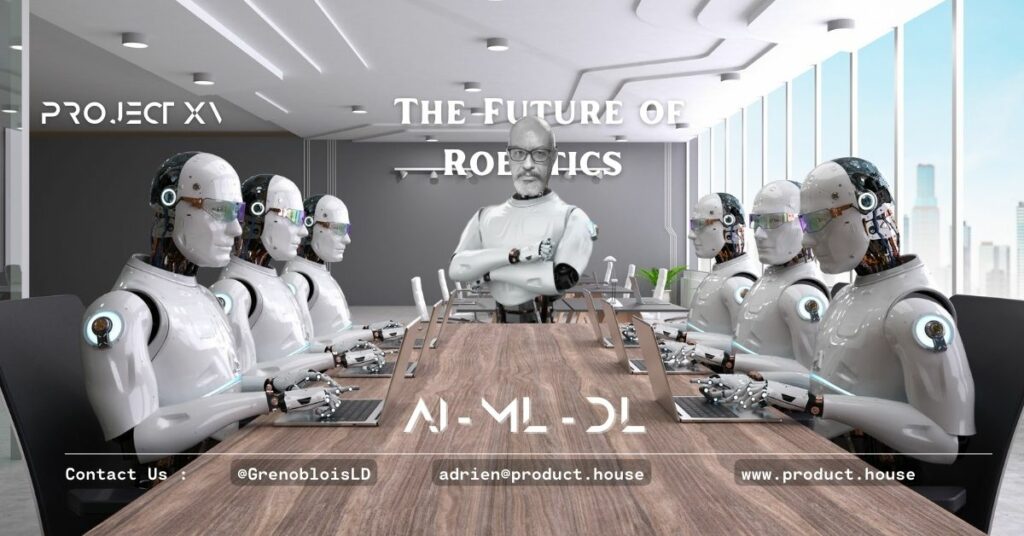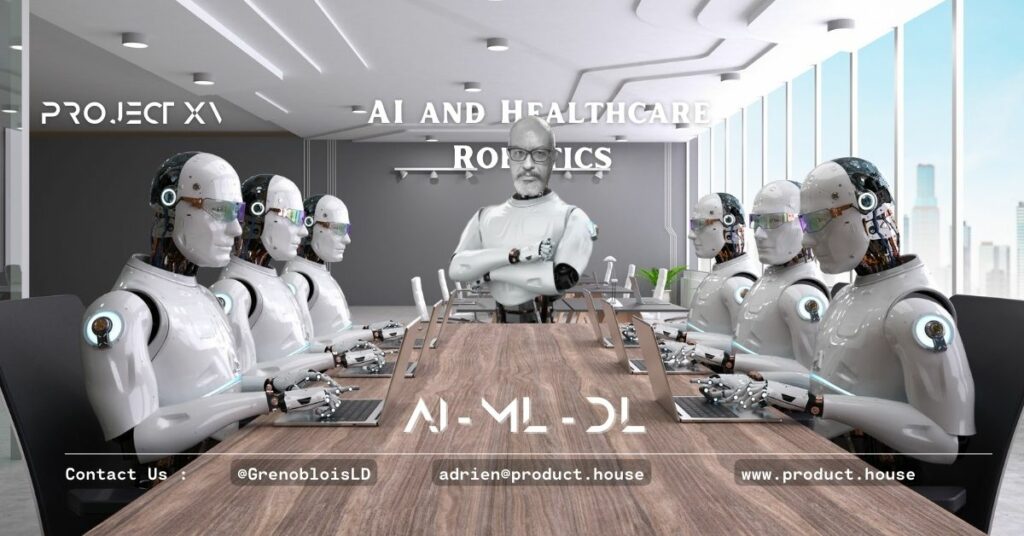The Future of Robotics: How AI Is Revolutionizing the Field

Introduction:
The field of robotics has seen significant advancements in recent years, with the integration of artificial intelligence (AI) leading to new capabilities and possibilities. From manufacturing and industry to healthcare and consumer goods, robotics and AI are revolutionizing the way we live and work.
Main Points:
Robotics and AI
The integration of AI into robotics has led to a new generation of robots that can learn, adapt, and respond to their environments. AI-powered robots have the ability to process data, make decisions, and interact with humans in more natural and intuitive ways.
Applications of Robotics and AI
Robotics and AI have a wide range of applications across industries. In manufacturing and industry, robots can perform repetitive and dangerous tasks with high precision and accuracy. In healthcare, robots can assist with surgeries and help patients with mobility impairments. In consumer goods, robots can help with cleaning and other household tasks.
Challenges and Limitations
While the potential of robotics and AI is immense, there are also challenges and limitations to consider. One major challenge is the ethical implications of using robots in various contexts. There are also concerns about job displacement and the potential for AI-powered robots to outperform human workers.
The Future of Robotics and AI
The future of robotics and AI is bright, with continued advancements in technology leading to even more capabilities and possibilities. The integration of robotics and AI will continue to transform industries and create new opportunities for innovation and growth.
FAQs:
- What is the difference between robotics and AI? Robotics refers to the design, construction, and operation of robots, while AI refers to the simulation of human intelligence in machines.
- What are the benefits of robotics and AI? The benefits of robotics and AI include increased efficiency, improved safety, and greater accuracy.
- How is AI integrated into robotics? AI is integrated into robotics through machine learning algorithms that allow robots to learn from their environments and adapt their behavior accordingly.
- What industries are impacted by robotics and AI? Robotics and AI impact a wide range of industries, including manufacturing, healthcare, and consumer goods.
- What are some challenges associated with robotics and AI? Challenges associated with robotics and AI include ethical implications, job displacement, and the potential for robots to outperform human workers.
- Will robots replace human workers? While robots are capable of performing many tasks currently performed by humans, it is unlikely that they will completely replace human workers.
- How will robotics and AI impact the future of work? Robotics and AI are expected to transform the future of work by creating new job opportunities and changing the nature of work in many industries.
- What are some of the ethical considerations associated with robotics and AI? Ethical considerations associated with robotics and AI include issues related to privacy, safety, and bias.
- How can robotics and AI be used to benefit society? Robotics and AI can be used to benefit society by improving efficiency, safety, and quality of life.
- What are some potential risks associated with robotics and AI? Potential risks associated with robotics and AI include job displacement, safety concerns, and ethical implications.
Resources:
- Robotics Business Review: https://www.roboticsbusinessreview.com/
- Robotics Trends: https://www.roboticstrends.com/
- IEEE Robotics and Automation Society: https://www.ieee-ras.org/
- Robohub: https://robohub.org/
- National Robotics Initiative: https://www.nsf.gov/funding/pgm_summ.jsp?pims_id=503641
Books:
- “Robotics: A Very Short Introduction” by Alan Winfield
- “Robotics: Everything You Need to Know About Robotics from Beginner to Expert” by Peter Mckinnon
- “Robotics: For Kids: Learn About Robotics and Programming” by Bill Stonehem 4. “Robotics: Discover the Science and Technology of the Future with 20 Projects” by Kathy Ceceri
- “Robotics: The Beginner’s Guide to Robotic Building, Technology, Mechanics, and Processes” by John Cook
“Robotics: A Very Short Introduction” by Alan Winfield:
This book is a concise and accessible introduction to the field of robotics, covering its history, development, applications, and challenges. The author is a professor of robot ethics and a leading researcher in robotics. He explains what robots are, how they work, and what they can do. He also explores the ethical and social implications of robotics, such as how robots affect human jobs, privacy, safety, and responsibility.
“Robotics: Everything You Need to Know About Robotics from Beginner to Expert” by Peter Mckinnon:
This book is a comprehensive guide for anyone who wants to learn about robotics. It covers the history, principles, and applications of robotics, as well as the challenges and opportunities that robotics offers. The book also provides practical tips and resources for building your own robots.
“Robotics: For Kids: Learn About Robotics and Programming” by Bill Stonehem:
The book is an introduction to robotics for kids who are interested in learning how robots work and how to program them. The book covers the basics of robotics, such as what robots are, how they sense their environment, and how they move and communicate. The book also teaches kids how to use Arduino, a popular platform for building and programming robots. The book provides step-by-step instructions for creating several projects, such as a robot arm, a line-following robot, and a voice-controlled robot. The book also explains the concepts of coding, logic, and algorithms that are essential for robotics. The book is designed to be fun and engaging for kids who want to explore the world of robotics.
Robotics: The Beginner’s Guide to Robotic Building, Technology, Mechanics, and Processes by John Cook
This is a book that introduces the basics of robotics to anyone who is interested in learning more about this fascinating field. The book covers topics such as:
- The history and evolution of robotics
- The different types of robots and their applications
- The main components and systems of a robot
- The principles and concepts of robotic mechanics and kinematics
- The methods and techniques of robotic programming and control
- The challenges and opportunities of robotics in the future
The book is written in a clear and engaging style, with plenty of examples, diagrams, and illustrations. It is suitable for beginners who want to get started with robotics, as well as for hobbyists who want to expand their knowledge and skills. The book also provides useful tips and resources for further learning.
Experts:
- Dr. Rodney Brooks, founder and former CTO of iRobot and current professor at MIT
- Dr. Cynthia Breazeal, director of the Personal Robots Group at MIT
- Dr. Ayanna Howard, chair of the School of Interactive Computing at Georgia Tech and founder of the Human-Automation Systems (HumAnS) Lab
- Dr. Robin Murphy, director of the Center for Robot-Assisted Search and Rescue at Texas A&M University
- Dr. Pieter Abbeel, director of the Berkeley Robot Learning Lab at the University of California, Berkeley
- Dr. Rodney Brooks is an Australian roboticist, author, and entrepreneur who is known for popularizing the actionist approach to robotics. He was a professor of robotics at MIT and former director of the MIT Artificial Intelligence Lab and the MIT Computer Science & Artificial Intelligence Lab. He is also a co-founder and former CTO of iRobot Corp, a company that produces consumer robots such as Roomba. He is currently the CTO and co-founder of Robust AI, a startup that aims to build industrial-grade cognitive engines for robots.
- Dr. Cynthia Breazeal is an American roboticist who is the director of the Personal Robots Group at MIT. She is also a founder and chief scientist of Jibo Inc, a company that develops social robots for home use. She is known for her research on human-robot interaction, social robotics, and affective computing. She has created several expressive robots such as Kismet, Leonardo, and Jibo.
- Dr. Ayanna Howard is an African-American roboticist who is the chair of the School of Interactive Computing at Georgia Tech and founder of the Human-Automation Systems (HumAnS) Lab. She is also a co-founder and chief technology officer of Zyrobotics LLC, a company that develops accessible technologies for children with special needs. She has worked on various projects involving robotics, artificial intelligence, computer vision, and human-centered computing.
- Dr. Robin Murphy is an American roboticist who is the director of the Center for Robot-Assisted Search and Rescue (CRASAR) at Texas A&M University. She is also a founder and president of Roboticists Without Borders, a group that provides robots and expertise for disaster response missions. She has deployed robots to various disasters such as 9/11 World Trade Center collapse, Hurricane Katrina, Fukushima Daiichi nuclear accident, and Nepal earthquake.
- Dr. Pieter Abbeel is a Belgian-American roboticist who is the director of the Berkeley Robot Learning Lab at UC Berkeley. He is also a co-founder and president of Covariant AI, a company that develops AI software for industrial robotics applications. He has conducted research on reinforcement learning, imitation learning, deep learning and robot control.
Case Studies:
- Boston Dynamics’ robots, which include the Atlas and Spot robots, are being used in various industries for tasks such as inspecting oil rigs and assisting with construction.
- The da Vinci Surgical System, developed by Intuitive Surgical, is used in hospitals for minimally invasive surgeries.
- Amazon’s Kiva robots are used in their warehouses to help with order fulfillment and inventory management.
- The Roomba robot vacuum cleaner, developed by iRobot, is a popular consumer robot that uses AI to navigate and clean homes.
- The Pepper robot, developed by SoftBank Robotics, is used in various settings such as retail and hospitality for customer service and engagement.
Glossary:
- Robotics: The design, construction, and operation of robots.
- Artificial Intelligence (AI): The simulation of human intelligence in machines that are programmed to learn, reason, and self-correct.
- Machine Learning: A type of AI that allows machines to learn from data and improve their performance over time.
- Ethics: The principles of right and wrong that govern individual or group behavior.
- Job Displacement: The loss of jobs due to automation and technological advancements.
- Machine Vision: The ability of machines to interpret visual information from the world around them.
- Automation: The use of machines and technology to perform tasks that would otherwise be done by humans.
- Natural Language Processing: The ability of machines to interpret and understand human language.
- Neural Networks: A type of machine learning algorithm that is modeled after the structure of the human brain.
- Deep Learning: A type of machine learning that uses artificial neural networks to learn from large amounts of data.
Quiz Questions:
- What is the difference between robotics and AI?
- What are some applications of robotics and AI?
- What are some challenges associated with robotics and AI?
- Will robots completely replace human workers?
- How can robotics and AI benefit society?
- What are some ethical considerations associated with robotics and AI?
- What is the da Vinci Surgical System?
- What is the Roomba robot?
- What is machine vision?
- What is deep learning?





